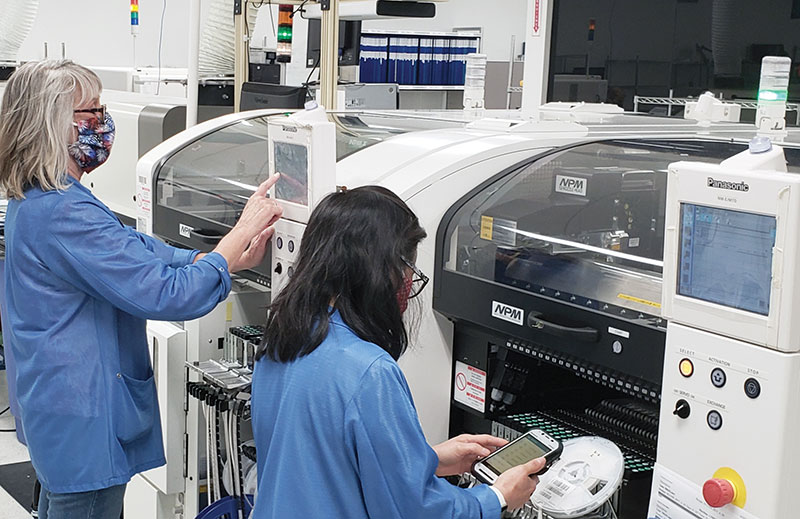Production Area Reorganization Pays Many Dividends
A new layout marries staff resources to immediate demand.
In the fourth quarter 2019, the team at Milwaukee Electronics’ headquarters began looking at ways to improve throughput by eliminating customer-focused cells and enhancing worker responsibilities. The goal was to make it easier to shift cross-trained employees among work cells to support variances in demand.
The electronics manufacturing services (EMS) facility was divided into five areas, each headed by a supervisor with direct responsibility for the team in that area. This put resource allocation in the hands of the people who work with those resources. Instead of dedicating space and team members to specific customers, each supervisor now has the flexibility to move their team around based on that day’s demand. They can also request additional training for any team member if they feel additional skills are necessary. Additionally, one supervisor was assigned as an assistant to the production manager. A production manager has finite bandwidth. The assignment of a roving supervisor to address day-to-day challenges helps ensure tactical issues don’t sidetrack the production manager from focusing on more strategic issues.
To continue reading, please log in or register using the link in the upper right corner of the page.
{!guest}
The five production areas are:
- SMT, which includes all activity associated with SMT placement and reflow.
- First assembly, which includes component preparation and all through-hole insertion processes.
- Second assembly, which includes post-wash operations, addition of non-wettable components, conformal coating and potting.
- Test, in which a team of test technicians now repairs test failures where they happen with debug data.
- Final assembly, which includes box build, labeling and any additional value-added activity.
Additionally, purchasing now “owns” material from the buy signal to the kit on the production floor. The final inspection area team now reports to corporate quality.

Figure 1. Production operators in Milwaukee Electronics’ SMT area.
This streamlined the processes, focusing each area on a business view where material flows in and completed assemblies flow out. Employees in each area now focus on eliminating roadblocks associated with the overall throughput in their area and are empowered to address those bottlenecks.
The process also has benefits at the individual employee level that have evolved substantially since inception. Initially, the major benefit was added skills. The company obtained a Wisconsin state training grant that funded courses developed by Milwaukee Area Technical College that were customized to defined requirements and included Lean manufacturing principles, basic electronics training and technician training and are delivered during normal work hours at the Milwaukee facility.
The course structure was designed to offer a career path. The training provides the skills needed for employees to move to higher levels of responsibility and compensation over time. The company has also found that having a production team with enhanced critical thinking skills improved productivity. As a result, the facility has been able to support business growth without having to hire a proportional amount of people. Where increasing process automation reduced headcount, personnel were redeployed to other jobs. During the Covid-19 pandemic, this facility has continued to work at normal capacity, as much of its production involved essential products, and several of those companies have increased orders. Area school closures did create a potential issue. Teams worked together to figure out how to move impacted employees among shifts to address childcare issues. Employees who did switch shifts also continued to support their prior team members with knowledge transfer where needed. Additionally, at a time when many workplaces were experiencing high absenteeism related to fear of Covid-19, the combination of the company’s safe work practices and work hour flexibility resulted in minimal absences. Employees felt the company was prioritizing their needs and recognized the need to help the company also follow through on its commitments to customers.
From a manufacturing efficiency standpoint, many lessons were learned. First, when employees were associated with dedicated work cells, they tended to work through inefficiencies, keeping a machine running or nursing a process recipe without making a permanent change. The combined result of job enhancement, additional training and focused kaizen events has eliminated this behavior, plus instilled a sense of greater ownership of results at all levels. Machine operators are programming machines and “owning” their metrics. Since operators now have a greater understanding of process elements that drive good quality, machines are cleaner and require less maintenance. This has freed manufacturing engineers to focus on process optimization. In the test area, technicians also own their results. Their training now includes electronics, circuit analysis, debug and usage instructions on all test equipment. As a result, they are now better able to troubleshoot and repair test failures, plus communicate trends to the production team.
Within the first two quarters of implementation, results included elimination of 70 bins of work-in-process (WIP). WIP queues between processes have shrunk as each process now works solely to actual demand. Covid-19 also created unanticipated variances in demand during the second quarter 2020, as essential customers stepped up orders to ensure they would have adequate inventory should the facility be shut down. Cross-training made it easy to shift employees to areas with expedited production requirements.
is vice president of engineering/Milwaukee plant manager at Milwaukee Electronics (milwaukeeelectronics.com); chanson@milwaukeeelectronics.com.
Register now for PCB West, the leading conference and exhibition for the printed circuit board industry! Coming this September to the Santa Clara Convention Center. pcbwest.com







